December 10, 2010
Air Date: December 10, 2010
FULL SHOW
SEGMENTS
Cancun REDD Wrap
View the page for this story
It was only a modest agreement without binding emission limits at the 16th UN climate summit that just wrapped up in Cancun, despite the urgency of changing weather patterns. There was progress on the scheme to lock up carbon in trees, called REDD, but as Living on Earth’s team in Cancun reports, stumbling blocks remain. (06:00)
Climate Conference Adopts Green Fund
View the page for this story
$100 billion to help poor countries adapt to a changing climate. That’s the decision at COP 16 – but vulnerable countries say they’ve yet to see pledges made after Copenhagen. Experts say the key to shaking loose the cash is setting a global price on carbon – but that seems unlikely in the short term given the US failure to pass climate legislation. (06:00)
Drought in the Amazon
View the page for this story
Rivers in the Amazon are drying up as the world's largest rainforest experiences increasingly frequent droughts. Dan Nepstad, Director of International Programs at the Amazon Environmental Research Institute, tells host Bruce Gellerman that such droughts are consistent with predictions for climate change. (03:45)
Damming the Amazon River
/ Bobby BascombView the page for this story
The Brazilian government is planning to build dozens of new hydroelectric dams in the Amazon river basin. It wants to develop the interior, and prevent power outages during the upcoming World Cup and the Olympics. Living on Earth's Bobby Bascomb visited a dam project on the Madeira River and reports on the environmental repercussions of hydropower in the Amazon. (14:15)
Feeding More People as the World Warms
View the page for this story
As global temperatures rise due to the effects of climate change, one steep challenge will be to feed a growing population. Inger Andersen, Vice President of Sustainable Development at the World Bank, shares some ideas for increasing the world’s agricultural production sustainably with host Steve Curwood. (04:35)
Yucatan Farmers
/ Bruce GellermanView the page for this story
While international delegates discuss how to save the world’s forest, host Bruce Gellerman goes straight to the source. Deep in the Yucatan jungle he finds not just trees but an ancient culture struggling to survive. (08:00)
Urgent Bid for Survival
View the page for this story
The urgent needs of countries already affected by climate change need to be addressed by the global community. And perhaps nowhere is that urgency more stark than in Kiribati, a small Pacific Island nation at risk of being swallowed by rising seas. Host Steve Curwood speaks with the president of Kiribati, Anote Tong, about what's at stake. (03:00)
This week's EarthEar selection
listen /
download
Listen to Caribbean Flamingos, herons, storks and kingfishers in Mexico's Yucatan Peninsula.
Show Credits and Funders
Show Transcript
HOSTS: Bruce Gellerman & Steve Curwood
GUESTS: Rosalind Reeve, Jens Stoltenberg, Dan Nepstad, Inger Andersen, Anote Tong
REPORTERS: Bobby Bascomb, Bruce Gellerman
[THEME]
GELLERMAN: From Public Radio International, this is Living on Earth. I’m Bruce Gellerman.
CURWOOD: And I’m Steve Curwood at the UN climate summit in Cancun Mexico. Mexico’s president tells delegates from 194 nations, “We have to change the way we do things or climate change will change us.”
GELLERMAN: The Prime Minister of Norway says changing climate change begins in the forest.
STOLTENBERG: Without any doubt addressing deforestation is the way we can have the largest, the fastest, and the cheapest reductions in emissions of carbon dioxide.
GELLERMAN: But for developing nations already confronting the effects of climate change time and money are running short.
RAMESH: So far the fast start finance has not been fast, nor has it started, and there's hardly been any finance.
CURWOOD: That and more from Cancun, this week on Living on Earth – No te vayas!
GELLERMAN: Stay with us.
[THEME]
Cancun REDD Wrap
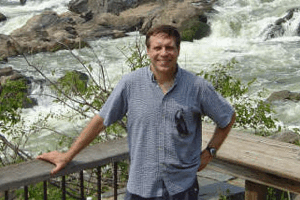
Duncan Marsh is Director of International Climate Policy at The Nature Conservancy. (The Nature Conservancy)
CURWOOD: From the UN Climate Summit in Cancun, Mexico, this is Living on Earth. I’m Steve Curwood.
GELLERMAN: And I’m Bruce Gellerman.
ANNOUNCER: Ladies and gentleman the president of the Mexican United States…
[MUSIC]
GELLERMAN: The pomp and security was what you’d expect under the circumstances - delegations from more than 190 nations had come to Cancun to deal with a planetary crisis, climate change. But security was so strict that many who had planned to attend the first day session were stuck in a two-hour checkpoint traffic jam. But by the end of the first week of the conference, many had found their way to see Mexican President Felipe Calderon talk about the importance of forests in the fight against climate change. Calderon got a standing ovation.

Oxfam encourages delegates to consider the needs of women. (Photo: Jennifer Stevens)
[SPEAKING IN SPANISH]
GELLERMAN: President Calderon told the crowd, “We have to change the way we do things or climate change will change us.” Two-dozen heads of state and governments attended the Cancun summit but one was conspicuously absent.
[CROWD CHANTING “Obama, Obama…respect Cohcibama…”]
GELLERMAN: Peasant farmers and their supporters held a press conference and demonstration to protest the UN climate talks, calling on U.S. President Barack Obama to stand up for indigenous rights, fearful that a negotiated treaty to curb greenhouse gases would come at the expense of those who had protected the environment for so long, but had profited the least.
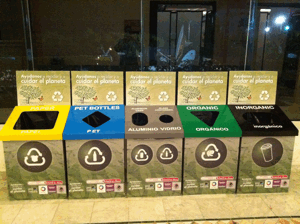
Recycling at COP16. (Photo: Jennifer Stevens)
In the wake of the failure of the last year’s climate talks in Copenhagen to reach a binding agreement, UN Secretary General Ban Ki-Moon told delegates in Cancun, time is running out.
BAN KI-MOON: We are here for one reason, to protect people and the planet from the uncontrolled climate change. Nature will not wait while we negotiate. The time for waiting while keeping one eye on everyone else is over.
GELLERMAN: Time is also running out for the UN climate conference process itself. This is the 16th COP or Convention of the Parties - the 16th annual meeting where the nations of the world have tried to seal a deal on greenhouse gas emissions and their effects. It’s a process that requires consensus by all 190-plus countries attending the meeting. Duncan Marsh is Director of International Climate Policy with The Nature Conservancy.

Duncan Marsh is Director of International Climate Policy at The Nature Conservancy. (The Nature Conservancy)
MARSH: We are facing the risk that countries are going to walk away from this process under the UN to deal with climate change, and that’s not optimal. For a global problem like climate change, we need a global solution where all nations are acting together.
GELLERMAN: Unlike the high expectations for last year’s climate meeting in Copenhagen - where a final agreement was anticipated - the hopes for the talks here in Cancun were decidedly lower, designed to shore up confidence in the UN process, building on the one issue where negotiators had worked out most differences, REDD, the UN mechanism for reducing emission from deforestation and degradation, putting a price on the carbon in trees so they’re worth more left standing than cut down. Rosalind Reeve is head of the forest team at London based NGO Global Witness.
REEVE: It really felt as if everybody engaged in REDD was converging toward one point, that we really were coming toward a consensus, but that consensus seems to be somewhat fractured.
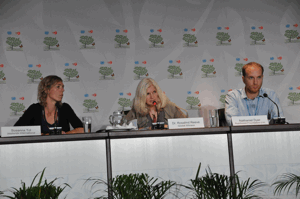
Rosalind Reeve is head of the forest team at Global Witness. (Photo: Jennifer Stevens)
GELLERMAN: An agreement on REDD was on the fast track in Cancun- stopping deforestation and replanting trees is considered the quickest way to reduce climate changing gases. It’s an amount equal to that emitted by all the vehicles in the world. REDD is especially important for countries like Indonesia, home to the world’s third largest tropical forest. Kuntoro Mangkusubroto, head of Indonesia’s REDD program, cautioned climate negotiators to slow down and get the complex REDD mechanism right.
MANGKUSUBROTO: We are introducing a new paradigm of development, so although we want this to happen very fast in Indonesia, we have to be very careful.
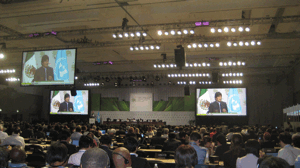
Bolivian President, Evo Morales at COP 16. (Photo: Jennifer Stevens)
GELLERMAN: Potentially at stake is hundreds of billion dollars in REDD forest credits. Many Indigenous groups and nations including Bolivia and Cuba oppose turning the carbon in trees into a commodity that can be bought and sold to offset industrial emissions. They believe developed nations should cut their greenhouse gases first, but supporters of a market based mechanism say it’s the only way to raise enough money to fund REDD. For billionaire financier George Soros, there’s gold in them thar trees.
SOROS: It has to be preservation, but it has to be a model of economic development, so I'm ready to invest in it and I think private enterprise has to play a major role.
GELLERMAN: Among nations Norway is the biggest supporter of REDD. It’s put more than two-billion dollars on the table for the forest-saving scheme, funding it with revenues from North Sea oil. Jens Stoltenberg, Prime Minister of Norway, says the nation’s leaders have also paid a high cost in political capital as well.
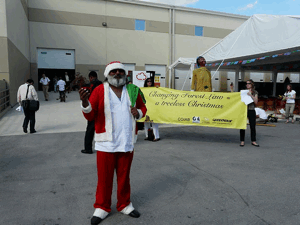
A call for a treeless Christmas from Greenpeace at the UN Climate convention. Deforestation releases as much carbon as all the world's vehicles combined. (Photo: Bruce Gellerman)
STOLTENBERG: We are a major oil exporter but we tax petroleum extremely high, and it’s hard to win elections based on a message of high taxation, so therefore I am very much dependent on success to show Norwegian voters that they are getting something back.
GELLERMAN: A major sticking point in the REDD negotiations in Cancun was verification. Donor nations want to make sure the carbon locked in trees - stays in the forests. Norway says it gave 250 million dollars to the world bank to fund REDD programs in Guyana, but Bharrat Jagdeo, President of the South American nation, says Guyana saved the trees- now show it the money.
JAGDEO: We have decided we have taken the tough political decision to pledge our entire forest, with the hope that we’ll get money or assistance to develop alternatives, and frankly speaking we have not seen a single cent.
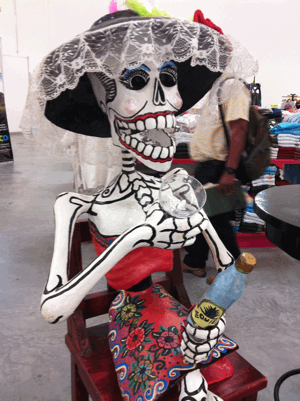
Climate delegates have a bone to pick with COP 16. (Photo: Jennifer Stevens)
GELLERMAN: Success for the climate talks in Cancun will be measured incrementally, when the UN looks to the summit next year in Durban, South Africa. And, as the Cancun meeting wound down, Roslind Reeve of Global Witness reflected on the speed of the process.
REEVE: What’s important is that we get the rules right. It’s better to wait than have a bad deal here.
[MUSIC: David Byrne/Brian Eno “I Feel My Stuff” from Everything That Happens Will Happen Today (Todomundo records 2010)].
Climate Conference Adopts Green Fund
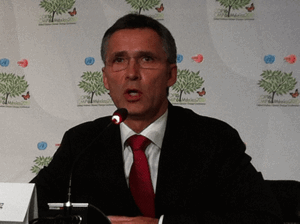
Jens Stoltenberg is Prime Minister of Norway. (Photo: Jennifer Stevens)
CURWOOD: Money, and lots of it. In fact, 100 billion dollars of it, every year come 2020. To help compensate for the lack of a binding agreement to cut emissions coming out of last year’s Copenhagen summit, the U.S. and other wealthy countries made that big pledge. It’s for developing countries to adapt to a changing climate and grow with less carbon. Jens Stoltenberg, prime minister of Norway, is the co-chair of a high level panel that was commissioned to prime negotiators in Cancun with practical ideas to meet those promises.
STOLTENBERG: It is challenging but feasible to mobilize the 100 billion we agreed on in Copenhagen.

Jens Stoltenberg is Prime Minister of Norway. (Photo: Jennifer Stevens)
CURWOOD: The advisory panel includes heads of state, and finance experts, bankers, international financier George Soros, and White House economic chief Lawrence Summers. The key to getting to 100 dollars billion a year, says Prime Minister Stoltenberg, is a price for carbon of no less than 20-25 dollars a ton. And the higher it is, the better the investment climate for developing countries.
STOLTENBERG: Especially the potential of auctioning emission allowances. We estimate that that can mobilize about 30 billion U.S. dollars annually, we look into potential of introducing carbon pricing for international aviation, international ships, that can provide about 10 billion U.S. dollars and we look into the potential of reallocating money going for subsidizing fossil fuels in the developed world—that can raise around 10 billion U.S. dollars.
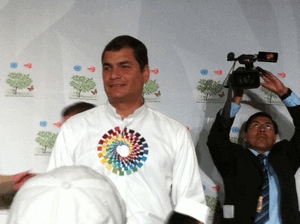
Rafael Correa, President of Ecuador. (Photo: Jennifer Stevens)
CURWOOD: You enumerated 50 billion, but there's another 50 billion to go, where do you expect to get that?
STOLTENBERG: From other sources. The reason why I mentioned this 50 billion was just to illustrate how big the potential is connected to carbon pricing.
CURWOOD: Prime Minister Stoltenberg went on to mention traditional foreign aid and private financing, helped by the World Bank and its regional partners. U.S. Envoy Todd Stern came to Cancun to say the U.S. is keeping its Copenhagen promises, including pitching in to a fund of 30 billion dollars right away over three years, so-called fast track money.
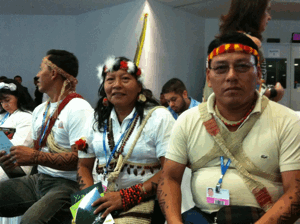
The delegation from Ecuador wears traditional dress. (Photo: Jennifer Stevens)
STERN: We have secured approximately 1.7 billion dollars worth of climate assistance in our first year of fast start financing that will support adaptation activities for the most vulnerable countries around the world, combat deforestation in the world’s most biologically diverse tropical forests, and help put countries on a path toward low-carbon development. Again, this is just the first of three years and we will be looking to increase that amount in each of the next two years.
CURWOOD: But fast track has come under fire for simply shuffling foreign aid from one category to another, rather than providing new funds. Jairem Ramesh, environment minister for India spoke for many developing countries.
RAMESH: So far the fast start finance has not been fast, nor has it started, and there's hardly been any finance. In fiscal year 2010, the total commitment of the United States to fast start finance is 1.7 billion dollars, which does no justice to the world's preeminent economic power.
CURWOOD: The problem, said Bharrat Jagdeo, the president of Guyana, is that the U.S. has no mandatory cap on carbon itself, and without a cap there’s nothing to auction or tax. He asked Americans in Cancun to carry home a message.
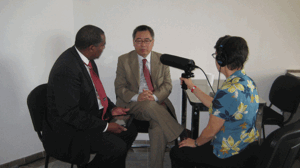
Living on Earth’s Steve Curwood interviews the delegate from China. Eileen Bolinsky engineers. (Photo: Jennifer Stevens)
JAGDEO: I ask you this as a favor. I was a member of the AG, and the advisory group on financing, the high-level group that the secretary general put together that the prime minister of Norway chaired. Could you please give president Obama a copy of that executive summary?
The copy says we can raise 100 billion dollars by 2020 easily if we have the right price signal, which is the only sustainable form for keeping this initiative going; particularly now when most countries are now in a state where they're not going to provide money, and that is why we have this dubious form of accounting on the fast track financing-- double counting, counting aid money, loop holes all of this, and very glossy brochures about how fast track financing has been disbursed!
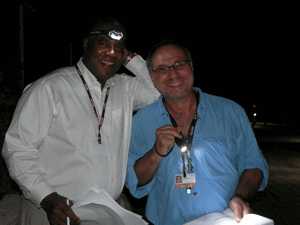
Steve & Bruce tracking scripts by flashlight. The UN meeting is so noising they have to go outside to record their stories. (Photo: Eileen Bolinsky)
CURWOOD: As some UN summit pundits like to say, climate protection in the developing world is spelled finance. But, loans and donations require good faith, and as UN climate negotiations drag toward the end of a second decade without worldwide limits on carbon emissions, it’s not only polar ice that’s disappearing, it’s also trust.
[MUSIC: New Cool Collective “Boca Arriba” from Out Of Office (Dox Records 2008).]
GELLERMAN: Just ahead, damming a river without water. Keep listening to Living on Earth!
[CUT-AWAY MUSIC: Aniceto Y Sus Fabulosos “Mi Gran Noche” from Cumbia Beat Vol 1 (Orchard Records 2009).]
Drought in the Amazon
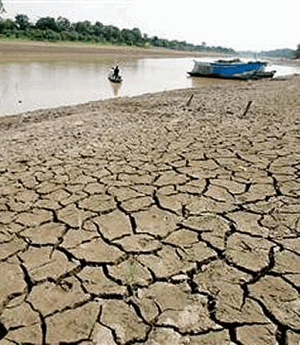
In northern Brazil some tributaries of the Amazon River have dried up, isolating rural communities. (Earth Week)
CURWOOD: It’s Living on Earth, I’m Steve Curwood.
GELLERMAN: And I’m Bruce Gellerman at the United Nations Climate talks in Cancun Mexico - where extreme weather around the world this year has given urgency to the negotiations. In Pakistan, an epic monsoon left a fifth of the country underwater. In Russia, a searing heat wave ignited massive forest fires, and in Brazil’s Amazon basin a record drought dried up many of the rivers that sustain the biologically rich rainforest. Tropical ecologist Dan Nepstad is Director of International Programs at IPAM, the Amazon Environmental Research Institute.
NEPSTAD: It’s about as bad as we’ve seen. I’ve been working in the Amazon for about 25 years now, and I haven’t seen anything like it. We thought we had the worst drought of the century in 2005, and this one is worse.
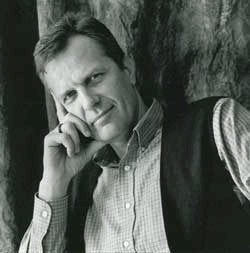
Dan Nepstad is Director of International Programs at the Amazon Environmental Research Institute. (Photo: Dan Nepstad)
GELLERMAN: That drought in 2005 was called a once-in-a-century drought. That’s five years ago.
NEPSTAD: I know. And, there was a drought in 2007 that didn’t even capture any immediate attention, it wasn’t even worth it because drought is really becoming part of the fabric of the Amazon. And that affects everything from when you plant your crops to whether or not forests are going to catch fire or not, to whether or not you can use your canoe or boat to get to school or the market or the nearest big city.
GELLERMAN: So what do you think is causing this drought?
NEPSTAD: You know, statistically, it’s just very hard to take an individual event like this mega-drought of the Amazon, and say that it is a direct cause of climate change. But, with both this and the 2005 and the 2007 drought, they’re all consistent with the scenario of increasing accumulation of greenhouse gasses in the atmosphere.
GELLERMAN: How does the drought affect the rainforest? And then I guess, how does the rainforest then affect the drought?

Drought in northern Brazil had dried up some tributaries of the Amazon River, isolating rural communities. (Earth Week)
NEPSTAD: The forest actually makes the rain in the Amazon. By the end of the dry season, a lot of Amazon trees are sucking water from the soil- it could be 60 feet beneath the ground surface. So, they’re going way down deep to get that water, so that they can keep their green lush canopy, even though they’ve been deprived of water for a few months. And, that water going into the atmosphere makes the clouds that makes the rain. Similarly, the rain coming down, if it weren’t for that rain, if those dry seasons got longer on a permanent basis, then that forest would cease to be. It would be replaced by grassy vegetations, savannahs, woodlands and scrub that would burn periodically, and that would look very different and have far fewer species.
GELLERMAN: These droughts are drying up the rivers. The rivers also drive hydroelectric dams. And, Brazil has a very ambitious program to build, what, 50,60 dams in the Amazon? How would these droughts affect them?
NEPSTAD: If you get droughts coming in on top of deforestation, you get much less prediction of energy. And, that’s the scenario that really isn’t taken into account when the big planners of the hydroelectric dams plan these projects. There are many other dams planned for the Madeira, which also has a great vulnerability to climate change. So, if rainfall breaks down and is inhibited, the big energy supplies that are counted on from these dams, will be suppressed during the dry season.
GELLERMAN: Dan Nepstad is with the Amazon Environmental Research Institute.
Related link:
IPAM
Damming the Amazon River
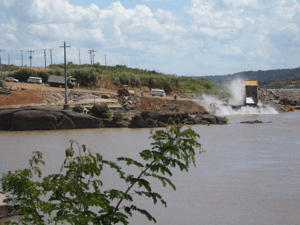
Trucks dump loads of rocks into the Madeira River to form the Santo Antonio Dam. (Photo: Bruce Gellerman)
CURWOOD: Though droughts are becoming more frequent and intense in the Amazon, Brazil is going full steam ahead with plans to build hydroelectric dams throughout the region. Brazil’s economy is booming and energy planners want to prevent power outages like the one last fall that left nearly a third of the country without electricity. And they desperately need to keep the lights on when Brazil hosts the World Cup in 2014 and the Olympics 2 years later. Living on Earth’s Bobby Bascomb traveled to the Amazon –where one of the major hydro-projects is in the works and she has our report from the Madeira River.
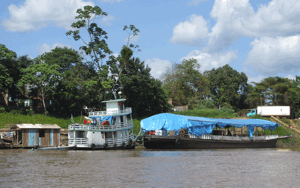
For $20 each, river boats like these carry passengers from Porto Velho to Manaus, a 4 day trip. (Photo: Bobby Bascomb)
[SFX SQUEAKING OF A PLANK, BOAT SOUNDS]
BASCOMB: From Porto Velho, in the Southwestern corner of the Amazon, the best--sometimes the only-- way to get around is by riverboat. A tree cut lengthwise serves as a squeaky foot-bridge between the shore and a floating dock on the Madeira River.
[SQUEAKING OF THE FOOT BRIDGE]
BASCOMB: Tied to the dock is a double-decker riverboat with peeling white paint and blue trim. A satellite dish sits on the roof, a group of men play pool…
[CLINK OF POOL BALLS]
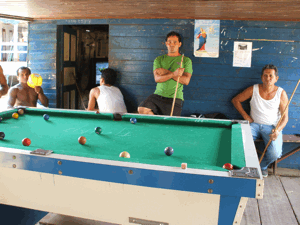
Playing pool on a river boat on the Madeira River (Photo: Bruce Gellerman)
BASCOMB: And, hammocks swing in the breeze.
[CARDOZO SPEAKING PORTUGUESE]
VOICE OVER: The first thing we do on the rivers of the Amazon here in Rondonia is ask permission to the river for us to navigate on it.
BASCOMB: Ivaneide Cardozo is petite, with long wavy black hair. Her father was a rubber tapper and she grew up in the forest with her family. Today she is head of Kaninde, an environmental NGO working to protect the Madeira River. She folds her hands together in prayer and speaks directly to the river.
[CARDOZO SPEAKING PORTUGUESE]
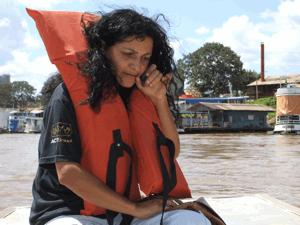
Ivaneide Cardozo is head of the environmental NGO, Kaninde. (Photo: Bruce Gellerman)
VOICE OVER: Rio Madeira, I want to ask you permission to come and do my work here and navigate on your waters. Thank you river.
CARDOZO: Obrigada Rio.
BASCOMB: Ivaneide leads the way across the riverboat to a small aluminum skiff tied up in the baking sun. We pull on bright orange life jackets and sit down carefully on the hot metal seats. Fish biologist Marco Lima is my translator in Brazil.
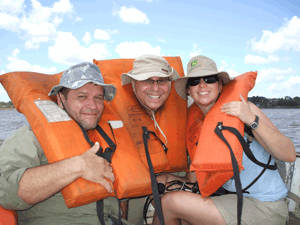
(Left to Right) Translator Marco Lima, LOE’s Bruce Gellerman and Bobby Bascomb head out on a boat to see the Santo Antonio dam under construction. (Photo: Bobby Bascomb)
LIMA: Sit down here, and I’ll sit in back.
BASCOMB: Okay.
LIMA: Watch out it’s really hot.
[SOUNDS OF MOTOR BOAT]
BASCOMB: We head up the largest tributary of the largest river in the world. The Madeira begins at the foot of the Andes Mountains in Bolivia and flows northwest to join the Amazon 2,000 miles away.
[SOUNDS OF MOTOR, WAVES]
BASCOMB: Madeira means wood in Portuguese, and we watch huge tree trunks float by. During the rainy season the river flows so fast that it erodes the banks and pulls giant rainforest trees out by their roots. The biodiversity of the Madeira River is legendary-- more than 800 species of birds, 33 species of mammals, and 750 species of fish: giant catfish and piranha, fresh water saw fish with long- toothed- bills. Ivaneide Cardozo scans the water and sees something exciting.
[COMMOTION IN THE BOAT IN PORTUGUESE]
LIMA: A big red dolphin! A pink dolphin!
[CARDOZO SPEAKING IN PORTUGUESE]
LIMA: Look over there. There is a bunch of dolphins.
BASCOMB: Like many of the species here, the endangered pink river dolphin is only found in the Amazon. Five miles up river we have gone as far as we are permitted. Marco ties the skiff to a log at the bottom of the riverbank. Just ahead big pick up trucks dump load after load of giant rocks into the river, the foundation of the Santo Antonio Dam.

Trucks dump loads of rocks into the Madeira River to form the Santo Antonio Dam. (Photo: Bruce Gellerman)
LIMA: As you can see, what they are starting to do here is that they are simply starting the damming of the whole Wood River.
[SOUNDS OF RUBBLE POURING INTO RIVER]
BASCOMB: Seven miles up river another dam, the Jirau, is quickly growing as well. Together the two dams should produce over 6,400 megawatts of electricity, roughly enough energy for all the homes in a city the size of Boston. The government created several short films to sell the dams to the public.
[SOUND OF GOVERNMENT FILM REGARDING THE DAMS IN PORTUGUESE]
VOICE OVER: The Santo Antonio and the Jirau dams on the Madeira River are important parts of the national effort to produce more energy so the country grows.
[SOUND OF GOVERNMENT FILM REGARDING THE DAMS IN PORTUGUESE]
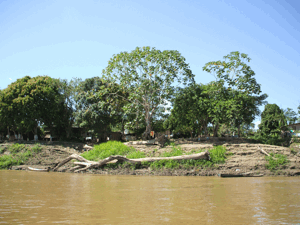
Rushing water from the Madeira River can pull rainforest trees out by their roots. (Photo: Bobby Bascomb)
VOICE OVER: We need more energy for industry, agriculture, houses and schools. We cannot develop without energy.
BASCOMB: About 80 percent of Brazil’s electricity comes from hydropower. So Brazil has a lot of experience with building dams, though not always successfully. Twenty-five years ago the Balbina dam, to power the city of Manaus, flooded nearly 1000 square miles of rainforest.
The decaying vegetation there produced massive amounts of the powerful greenhouse gas methane, yet the dam generated only 112 megawatts of electricity. That would power 33,000 U.S. homes. But Santo Antonio Energia says the Santo Antonio dam will be different. Ricardo Ovis is the sustainability manager.
[OVIS SPEAKING PORTUGUESE]
VOICE OVER: Of all the hydro plants in Brazil this will have the least impact. For six years we’ve had consultants coming from several institutions in Brazil. They told us what we needed to do to minimize the possible future impacts.
BASCOMB: Yet Ivaneide Cardozo remains skeptical.
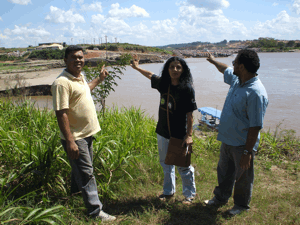
Ivaneide Cardozo (center) with two Kaninde workers points towards where the Santo Antonio dam will be. (Photo: Bruce Gellerman)
[CARDOZO SPEAKING PORTUGUESE]
VOICE OVER: What we want is development, yes, but development that respects the people, human rights, and the environment. With this dam there will be incredible deforestation and such a big impact on the indigenous people and riverine people who live along the river.
BASCOMB: Many people living along the river depend on it for their food.
FEARNSIDE: It’s one of the rivers in the Amazon that has the most fish.
BASCOMB: Phillip Fearnside is an ecologist with INPA, the Brazilian National Institute for Research in the Amazon. He’s tall, lanky, and has a thick gray mustache that covers his entire mouth.
FEARNSIDE: It supplies the baby fish for the whole system. That’s important for the fish that breed in the headwaters of the Madeira and then go down stream into the main part of the Amazon and grow to their huge size.
BASCOMB: The giant Amazonian catfish can grow up to nine feet long and 600 pounds. They are literally man-eaters, infamous for tearing legs and arms off SCUBA divers and swimmers. From the mouth of the Amazon at the Atlantic Ocean, adult catfish swim the length of the Maderia to the Andes Mountains to breed. It’s 3,000 miles against the current.
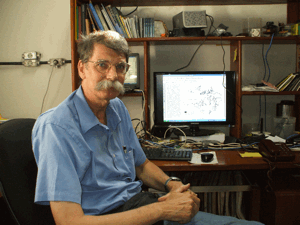
Amazon research scientist Phillip Fearnside. (Photo: Bobby Bascomb)
The developers plan to build channels around the dams for catfish and other migratory species to pass through.
FEARNSIDE: Nobody knows if that will work or not.
BASCOMB: Again, Phillip Fearnside.
FEARNSIDE: No one’s done it with these catfish before. It’s not like salmon or trout or something that people have a lot of experience with.
BASCOMB: Unlike salmon or trout, catfish are bottom dwellers. And scientists just don’t know how they will navigate through a fish channel.
FEARNSIDE: So, it’s likely that they won’t make it past these barriers. But even if they do make it to Peru and Bolivia and breed, the larvae fish come floating down the river - when they get to the turbines they’ll be sucked through the turbines because they won’t be swimming around the edge to these side channels.
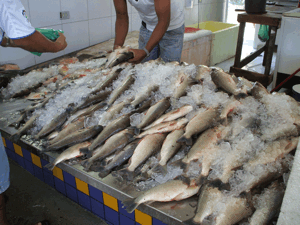
In the Amazon 98 percent of the fish sold in markets are migratory. Scientists and local communities are concerned about the future of the fisheries once a dam is in place. (Photo: Bobby Bascomb)
BASCOMB: Another danger for any fish that do survive is mercury poisoning. Thirty years ago the Madeira River basin was brimming with gold miners. They used mercury to separate out the gold and threw the waste into the river. Mercury settles to the bottom unless rushing water from a dam churns it up.
Researchers already see elevated levels of mercury in many communities that depend on river fish for food. A World Wildlife Fund video titled “The Madeira River: Life Before the Dams” documents the lives of indigenous tribes like the Parintintin who live along the river.
CLICK HERE FOR THE WORLD WILDLIFE VIDEO, "LIFE BEFORE THE DAMS"
[PARINTINTIN MAN SPEAKING PORTUGUESE]
VOICE OVER: Today the supermarket for the Indians is the river. The non-Indians in the city goes to the market to buy a kilo of beef or fish. And when they build this dam what happens to the culture of the Indian whose livelihood is fishing? Is somebody going to bring food here? No, nobody will.
BASCOMB: A hundred miles upstream from the Santo Antonio dam is the non- indigenous community of Mutumparana. The supermarket is in the center of town, where several dirt roads meet.
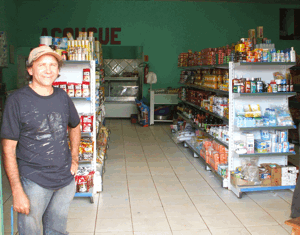
The supermarket in Muntumparana. (Photo: Bobby Bascomb)
[SOUNDS FROM SHOPPING MARKET]
BASCOMB: Shoppers bustle in and out buying fruit juice, pasta and vegetables. Jose Fidehamaya has owned this store for 32 years. When the dam is finished the village will disappear under water and Fidehamaya and his customers will move to a new town the government is building for them.
[FIDEHAMAYA SPEAKING PORTUGUESE]
VOICE OVER: My expectation is to be really cool, because we are expecting to move for better.
BASCOMB: Jose bags a few canned goods for Fransica, a regular customer. He uses a calculator to figure out her total, then flips through a spiral bound note book to find her name.
[SOUND OF PAGE TURNING]
[FIDEHAMAYA SPEAKING PORTUGUESE]
VOICE OVER: Well let me tell you the way I do. I simply buy and what ever the people can pay me they pay and what ever they can’t pay they pay at the end of the month, when they receive their salaries.
BASCOMB: So, will you take that same business model with you to the new community?
[FIDEHAMAYA SPEAKING PORTUGUESE]
VOICE OVER: Oh, no! Over there I’m going to use a computer. I’m going to finish, terminate this book right here.
BASCOMB: His customer, Fransisca, says she’s also looking forward to the move.
[FRANSISCA SPEAKING PORTUGUESE]
VOICE OVER: For me, I think it will be better. Life here is not easy. This area has a lot of malaria. We suffer a lot in this place. I’m not going to miss it.
BASCOMB: But not everyone in Mutumparana is eager to pack their bags.

A home in the village of Mutumparana (Photo: Bobby Bascomb)
[DOG BARKS]
BASCOMB: Maria Jose sits on the back porch with her dog facing the garden. Inside her children watch a TV game show.
[MARIA JOSE SPEAKING PORTUGUESE]
VOICE OVER: This place is so peaceful by the river. I have a lot of memories from this place. But we have to leave. We are obligated.
BASCOMB: The outgoing president of Brazil, Luiz Inacio Lula de Silva has an 80 percent approval rating. He’s made development, jobs, and dam construction the hallmarks of his administration.
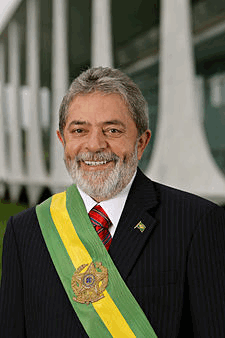
Outgoing president of Brazil Luiz Inacio Lula De Silva. (Wiki Commons)
[LULA SPEAKING PORTUGUESE]
VOICE OVER: We are building a hydroelectric dam that is a model for the world and we will continue building. Our most important concern is the Brazilian people.
BASCOMB: Brazilians love Lula but many observers see a conflict of interest. Brazil’s largest construction company, Odebrecht, is pouring the concrete on the Madeira River. The company also poured a lot of money into President Lula’s campaign fund.
Lula’s hand picked successor, Dilma Rousseff, shares Lula’s ambitions for Brazil. She recently won the presidential election but earlier in her career she was head of the agency that approved projects like the Madeira River dams.

Dilma Rousseff, President Elect of Brazil. (Photo: Wiki Commons)
[ROUSSEFF SPEAKING PORTUGUESE]
VOICE OVER: It’s necessary to realize our potential. If we think of our country as small it will stay small. Or we can think big, for example the hydroelectric dams.
BASCOMB: At first IBAMA- Brazil’s version of the EPA- denied approval for the dams, saying the environmental review was inadequate. Lula’s government ordered IBAMA to approve the dams anyway.
The director of the agency at the time was forced to resign and a few months later IBAMA gave the green light, stipulating 33 changes to mitigate environmental damage. Cesar Guimares is chief of IBAMA in the state of Rondonia, where the Madeira River dams are being built.
[GUIMARES SPEAKING PORTUGUESE]
VOICE OVER: Political pressures will always exist but we need to remember that we need a clean environment to live well.
BASCOMB: I’m wondering if you ever feel threatened to do what people want you to do in terms of approving the dam project.
[GUIMARES SPEAKING PORTUGUESE]
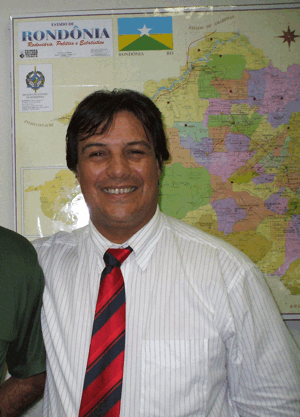
Cesar Guimares is the chief of IBAMA, Brazil’s environmental law enforcement agency in Rhondonia. (Photo: Bobby Bascomb)
VOICE OVER: I love my job but this threat is not only to me, but to other agents and the institution. But it is my duty.
BASCOMB: After we stopped recording Guimaraes’ cell phone rang. He didn’t answer it. He says he often doesn’t answer his phone because it could be a death threat. His job- enforcing environmental law busting illegal loggers and poachers - makes him unpopular. Many in the scientific community say the environmental impact statement IBAMA finally signed off on is still inadequate. Research scientist, Philip Fearnside.
FEARNSIDE: The environmental impact process had virtually no affect on the actual decision of whether they were going to make the dam or not. They already decided to make it before they had information about what the impact would be and the reports themselves don’t cover the impact very well.
BASCOMB: Fearnside says the environmental review only examined impacts upstream of the dams and stopped at the Bolivian border. It didn’t consider floods on the Bolivian side of the river, the methane the dam would create, or how ecosystems and communities down stream will be affected. And, Fearniside says the government sold the dams to the Brazilian people under false pretenses.
FEARNSIDE: One gets the impression this electricity is going to be lighting the light bulb in your house, and your television and so forth, and that’s really a very small part of it. A lot of this electricity is going for making aluminum, for example, that’s exported to the rest of the world.
BASCOMB: A Brazilian smelter can use as much energy as a city of a million people. In the end, Fearnside says the benefits might not outweigh the costs.
FEARNSIDE: No body has counted up all these impacts of these dams that are destroying the fisheries, emitting greenhouse gases. All these things, you have to add all these things up and compare them with what Brazil is getting in benefits.
BASCOMB: The Madeira River dams are just two of 60 such projects planned for the Brazilian Amazon, part of a huge international development to connect the countries of South America with paved roads and waterways so export goods like soy can be transported to the coasts more cheaply.
[WATER SOUNDS, CONSTRUCTION SOUNDS]
BASCOMB: Back in Rondonia the Madeira River continues to flow freely to the Atlantic Ocean, just as it has since the Andes Mountains rose up ten million years ago. But not for much longer. Construction of the Jirau and Santo Antonio dams continues around the clock and they’ll both be finished within two years.
[SOUNDS OF DAM CONSTRUCTION]
BASCOMB: For Living On Earth I’m Bobby Bascomb in Porto Velho, Brazil.
Related links:
- INPA- Brazilian National Institute for Research in the Amazon
- Kaninde
- International Rivers on the Madeira River Dams
[MUSIC: Cal Tjader “Amazon” from Mambo Sangria (Acrobat Music 2004).]
CURWOOD: Just ahead – heading deep into the Yucatan forest in search of chewing gum. Stay tuned to Living on Earth.
[CUT-AWAY MUSIC: Gabor Szabo “Amazon” from High Contrast (Blue Thumb Records 1971).]
Feeding More People as the World Warms
GELLERMAN: From the Cancun Climate Summit, it’s Living on Earth. I’m Bruce Gellerman.
CURWOOD: And I’m Steve Curwood. With consumption increasing and world population and temperatures rising, the danger is rising of shocks to the food supply. Crop yields fell by 30 percent seven years ago in France during a heat wave that also killed more than 14,000. And the subsistence agriculture that 70 percent of developing world depends on is even more vulnerable to extreme weather. But according to Inger Andersen, the vice president of Sustainable Development at the World Bank, the world need not descend into widespread famine if action is taken now.
ANDERSEN: As the population is rising, the nine billion people that we will have by 2050 we need to increase the productivity of the agricultural sector by about two and a quarter times. That’s huge. But, it’s also doable. But that means that we need to bring together research, we need to bring together efficiencies and we need to look at carbon positive agriculture. Agriculture can no longer be about expanding, but it must be about more crop per drop, more crop per square inch, and being smarter and wiser about the way we grow and consume our foods.
CURWOOD: What are some of the most important sustainable ways to increase crop yields?
ANDERSEN: Now I’m talking about poor farmers. This poor farmer who lives on a hill top in Ethiopia, at 4,000 meters above sea level, in scorching summers and very cold nights, he or she will want to see that the soil erosion that they have experienced, where the trees are gone, so that the soil depth is very thin- they need to find ways that they can bring back soil fertility to some of these soils.
And, what does that look like? It looks like you plant some trees, it looks like you ensure that the dung from the cows are collected and spread out on their farms, it looks like you make sure that the kind of species you grow are not those that deplete the soils, but rather are those that enrich the soils. These are the kind of things that need to happen, but not on a small pilot scale, they need to be scaled up.
When you see what I have seen, what was, you could describe it as a moon landscape, with a few rocks and a little house and nothing more, and a soil depth that is not more than ten to 20 inches, transformed over a five to seven year period where you also ensure that your small goats and your small sheep don’t run that you have them in one enclosed area, so you’ve cut and carry, as they say, the grass. And, you ensure that you do some landscaping and some terracing of some crops. It is a landscape completely transformed. You would not believe what you would see from prior to post. And, so there are answers. But there are answers that for that very poor family, needs a little help.
CURWOOD: Let’s talk about the World Bank for a moment. World Bank means money- lots of money- but how much money for sustainable agriculture?
ANDERSEN: So, we’ve been increasing our agricultural lending and support over the last six years, in fact, we’ve increased it rapidly. In Africa alone, we’ve doubled it. It now is about one billion a year, for Africa alone, just to give you an example. The reason being is that there is a great demand. We respond to client countries that ask for our support.
And, there is a clarity also, that it is agriculture that deals with the whole supply chain- from farm to fork. Our partner countries are asking us increasingly for support to ensure that the markets function, that the border crossings function, that the roads are there that the ports are there. Because otherwise, you find that productivity ahs gone up, but that it can actually not be distributed.
CURWOOD: People listening to us who are perhaps engaged on food in the United States will think of organic, local- how does this apply to what you at the World Bank are bringing to the World Food Supply?
ANDERSEN: Well, most of the poor people, in fact, are growing much of their agriculture is organic because they do not have the funds or the means to buy expensive chemicals. In Europe, the U.S. and other places where people are wealthier, and where we find that there is a demand on local foods, I think that that is a wonderful thing. You’ll find that most poor people are already buying local foods.
CURWOOD: Well, I want to thank you for taking this time. Inger Andersen is the Vice President for Sustainable Development at the World Bank.
ANDERSEN: Thank you very much for the opportunity.
[MUSIC: Various Artists/Azymuth “Amazon Adventure (Jazzanova remix)” from Brazilian Love Affair Vol 2 (Far Out Recordings 2007).]
Yucatan Farmers
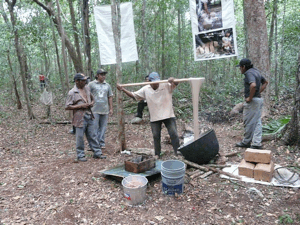
Boiling the natural latex gum to produce bricks of oro blanco - white gold - that will be turned into chewing gum. (Photo: Bruce Gellerman)
[SOUNDS OF OCEAN]
GELLERMAN: Cancun’s white, powder beach only seems to stretch forever. Earlier this year 15 miles of sand had to be brought in and the beach completely rebuilt after a storm washed Cancun’s sand into the Caribbean Sea. And scientists warn global warning is melting the polar ice caps, threatening low lying places like Cancun.
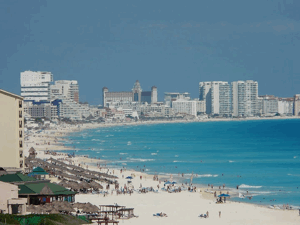
Mexico's high-rise hotels along the Mayan Riviera. No fun in the sun. A hurricane washed the entire 15 mile beach into the Caribbean Sea. It cost $80 million dollars to rebuild. (Photo: Bruce Gellerman)
[MUSIC]
GELLERMAN: The rising tide is in sight, but for most of the four million tourists who come to Cancun each year for sun, sand and fun, climate change is largely out of mind.
TOURIST: It’s my first time here, from the United States. It’s absolutely gorgeous, the water is really, really nice. I’m being treated extremely well. The rooms are really nice. It’s beautiful to be sitting out here. I love it.
GELLERMAN: The United Nations climate summit was held in the sprawling Moon Palace Hotel complex on Cancun’s beach - they call it the Mayan Riviera, but if you’re looking for authentic Mayan culture this place may as well be on the moon.
To see the real thing I traveled with three-van loads of international journalists covering the UN climate negotiations.
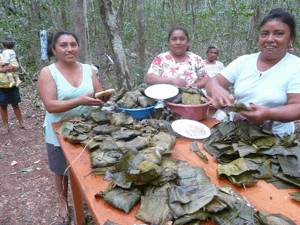
Women on ejido San Antonio Tuk serve lunch for visiting journalists. (Photo: Bruce Gellerman)
[SOUND OF JUNGLE WALKING]
GELLERMAN: It was a five hour journey - and a world away from Cancun - deep into the Yucatan jungle.
All right here we are walking through the forest. It’s a deciduous forest so there are a lot of leaves and underbrush but it’s a very, very dense forest.
The forest is thick with mahogany and cedar, twisted vines, thin scrawny trees and soaring evergreens. Tarzan would feel right at home here - but at a clearing in the woods there’s an unexpected sight.
[SOUND OF CLAPPING]
GELLERMAN: It’s a full blown press event, right here, in the middle of a semi-tropical jungle, in the middle of the Yucatan Peninsula.
[HERNENDEZ SPEAKING SPANISH]
TRANSLATOR: This is Archimedes Hernendez, he’s going to help us with the organization of the event, and he’s going to conduct you to the different parts of this area…
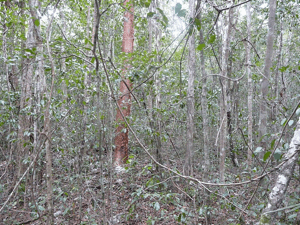
A typical view of the Yucatan Jungle. (Photo: Bruce Gellerman)
[APPLAUSE]
GELLERMAN: Dozen of Mayan forest people have gathered to welcome the visiting reporters. Each of us gets baseball cap with a logo in Mayan, advertising their community agricultural project. Seventy percent of Mexico’s vast forest area is owned by indigenous communities called ejidos or cooperatives.
[SOUND OF JUNGLE WALKING]
GELLERMAN: This ejido, called San Antonio Tuk, has 159 members. They communally own 15 thousand acres-of forest, home to ant eaters, parrots, boa constrictors and jaguar.
Four years ago, the Mexican federal government began paying ejidoistas about 12 dollars an acre a year, to inventory their trees, helping the Maya to get ready for REDD, the UN plan to reduce carbon emissions from deforestation and degradation.
[HERNENDEZ SPEAKING SPANISH]
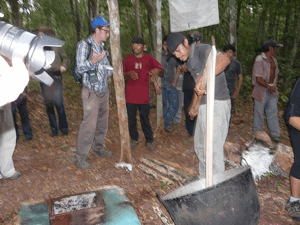
Visting journalist get the story of how natural gum is harvested and processed at ejido San Antonio Tuk. (Bruce Gellerman)
TRANSLATOR: The main objective of San Antonio Tuk with this project is that they want to have more economic support. They are having programs that help them preserve their traditions.
[HERNENDEZ SPEAKING SPANISH]
TRANSLATOR: With this project they also hope to reduce the emissions from deforestation, and degradation.
GELLERMAN: The two goals - preserving the ancient Mayan culture and the forest - is why the members of ejido San Antonio Tuk support REDD. Besides the federal money the community receives for managing the forest in a sustainable way, replanting trees and repairing damaged land, they hope to be able to trade the carbon stored in trees to industrialized countries that want to offset their emissions. It’s economic development designed to lift the Maya from subsistence farming.
[LOPE SPEAKING SPANISH]
GELLERMAN: Eighty year-old year old Catalyna Brezenya Lope remembers what it was like when the community was forced by famine to move to this part of the forest 60 years ago.
[LOPE SPEAKING SPANISH]
TRANSLATOR: She says that when she came here there was nothing, absolutely nothing. They had to build everything, not only a road. And she says the only path they had was the one for the horses carrying the chewing gum. That was it.

Gum from Ejido San Antonio Tuk (Photo: Bruce Gellerman)
GELLERMAN: You heard right- chewing gum. The natural latex gum found in the chicozapote trees, here on the Yucatan was once the most profitable forest product from these forests. The Mayan call it oro blanco- white gold.
[SOUND OF CHICELERO’S MACHETE]
GELLERMAN: A chiclero harvests the gum from the tree the way its been done for generations. He straps on poyas - spurs on his feet- wraps a thick rope around the tree and himself, and inches up, hacking the bark with his machete just deep enough in a z pattern so the sap flows into a canvas bag on the ground. The thick latex is boiled and shaped into ten kilo bricks.
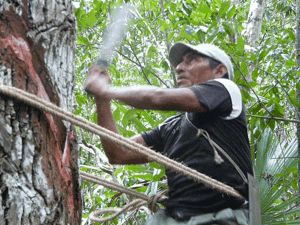
A chiclero hacks at a gum tree to save a forest and a society. (Photo: Bruce Gellerman)
The Maya chicleros used to sell their white gold to U.S. chewing gum companies. But in the 1950’s manufacturers began switching to latex made from petro-chemicals and the value of natural gum and the latex trees sank.
Today, organic chicle is just a fraction of a fraction of the 19 billion dollar a year chewing gum industry. But an association of ejidos is trying to revive the traditional forest product.
[MAN SPEAKING SPANISH]
GELLERMAN: A kilo of organic, natural gum goes for 55 pesos - about five dollars. The ejidos sell it a European manufacturer.
[MAN SPEAKING SPANISH]
GELLERMAN: So how important is this product to your community?
[MAN SPEAKING SPANISH]
TRANSLATOR: The way they extract this gum it represents their traditions and culture, a part of supporting their families.

Boiling the natural latex gum to produce bricks of oro blanco- white gold that will be turned into chewing gum. (Photo: Bruce Gellerman)
GELLERMAN: The chicle trees can be harvested once every three to seven years, after the wounds hacked into the bark heal. But today, there’s a new threat to the Mayan economic and cultural mainstay - climate change.
[MAN SPEAKING SPANISH]
TRANSLATOR: Fifty years ago we were able to extract five kilos of chicle, but nowadays with to global warming we can only extract one kilo and a half.
GELLERMAN: How does the change in temperature effect the tree?
[MAN SPEAKING SPANISH]
TRANSLATOR: This problem is due to the pollution produced by factories, and fires that have been taking place here, and in general by the pollution.
GELLERMAN: The Mayan cooperative culture has the strong social structure and governance needed to prevent illegal logging and insure the money from REDD projects goes to those who own the trees. At San Antonio Tuk violators are banished from the collective. It’s happened just once in the four years the ejido has been getting money from the Mexican government to prepare for REDD.
What needs to be improved to make this project even better?
[MAN SPEAKING SPANISH]
TRANSLATOR: They want more support from other people, organizations…
GELLERMAN: Government? NGOs?
TRANSLATOR: Particular people, everyone.
GELLERMAN: What happens if this program doesn’t exist - what happens to your people?
[MAN SPEAKING SPANISH]
TRANSLATOR: The forest can disappear. The forest can disappear.
[MUSIC: Chicalero “Geografia Musical” from Policarpo Aguilar (Bahia Del Sol Records 2009).]
Urgent Bid for Survival

Kiribati president, Anote Tong, with host Steve Curwood. (Photo: Jennifer Stevens)
CURWOOD: The end of this Climate summit in Cancun Mexico felt like déjà vu—folks wrangling, wheeling and dealing, deciding once more to decide the big stuff next year. But the climate itself didn’t wait; it continues to change. Kiribati is a small Pacific Island nation that’s just six feet above sea level, and every day a bit more disappears. Anote Tong is the president of Kiribati. I asked him how he would sum up this summit.

The small Pacific island country of Kiribati is already feeling the affects of climate change. (Photo: Toes in the Sand 1)
TONG: Well, I think it’s important to emphasize that time is running out. Not just with the wider cushion of climate change crisis, but I think that there are countries now- this would include the most vulnerable, which are already feeling the impact of what is happening.
I was in Parliament last week, and I was getting requests which have been happening virtually every Parliament, for government to provide protective seawalls, because buildings are already on the verge of being washed away. Already some have been washed away and some villages, communities, have had to be relocated. And, so, these are already happening. And so, it’s not about tomorrow, things that are going to happen, but it’s about things that are already happening.
CURWOOD: In terms of what has happened here in Cancun, is it enough, today, for what needs to be done?
TONG: There has to be agreement on addressing the more urgent needs of those countries which are already being affected. If that is not addressed, then there is no point to the negotiations, because it will be too late for some of us.
CURWOOD: In terms of finance, Ban Ki-Moon set together this panel, advisory panel, to come up with an international plan- what do you think of this?

Kiribati president, Anote Tong, with host Steve Curwood. (Photo: Jennifer Stevens)
TONG: Well, there are a lot of pledges made in Copenhagen. We did not sign the Copenhagen Accord because it did not meet the requirements, the minimum requirements that would ensure our survival. But, we subsequently associated with it, on the basis that it would trigger the flow of fast funds. Nothing has flowed until now. So, we do need funds urgently to meet these requirements.
CURWOOD: So, wait a second, here you are, the president of Kiribati, a country that is, at best six feet above sea level, all this promise of money, to help you deal with the problems, you need to build seawalls- but no money has come?
TONG: I think that the urgency of the whole process is being misunderstood. We are still negotiating and I think that was the point that I have been making all the time. It’s not a negotiation for us; it’s an urgent bid for survival. And, it’s happening. We don’t want to allow it to happen in larger scale, before it is too late for us, and too costly, if ever any work is going to be done to restore the integrity of the islands.
CURWOOD: Ok, well, thank you, sir. Anote Tong, President of Kiribati.
TONG: You’re very welcome indeed.
[MUSIC: Gorillaz “Hong Kong” from Help!: A Day In The Life (War Child Records 2005).]
CURWOOD: On the next Living on Earth – a prescription for global survival from one of the world’s leading ecologists: cut the calories.
SUZUKI: We are consuming over 80 percent of the planet’s resources even though we’re only 20 percent of the world’s population. We are the major predator of the planet.
CURWOOD: David Suzuki says it’s time to realize more is less, next time on Living on Earth.
[BIRD SOUNDS]
GELLERMAN: We leave you this week in a coastal lagoon in Mexico’s Yucatan Peninsula. A hundred eighty bird species live in the Ria Lagartos Biosphere Reserve, including Caribbean Flamingos, herons, storks and kingfishers. Over 140 migratory species visit, as well – more than a quarter of a million birds amid the palms and mangroves and coastal dunes. Antonio Celis-Murillo recorded this soundscape for the CD “Bird Songs of Mexico.”
[BIRD SOUNDS: “Bird Songs of Mexico.” Recorded by: Antonio Celis-Murillo.]
CURWOOD: Living on Earth is produced by the World Media Foundation. Our crew includes Bobby Bascomb, Eileen Bolinsky, Ingrid Lobet, Helen Palmer, Jessica Ilyse Smith, Ike Sriskandarajah, Mitra Taj, and Jeff Young, with help from Sarah Calkins, Sammy Sousa, and Emily Guerin. Our interns are Nora Doyle-Burr and Honah Liles. We had engineering help this week from Dana Chisholm.
GELLERMAN: Special thanks to Gretchen Weber of KQED and Ugochi Anyaka of the Climate Change Media Program. Jeff Turton is our technical director. Alison Lirish Dean composed our themes. You can find us anytime at L-O-E dot org, and while you’re online, check out our sister program, Planet Harmony. Planet Harmony welcomes all and pays special attention to stories affecting communities of color. Log on and join the discussion at my planet harmony dot com. And don’t forget to check out our Facebook page, PRI’s Living on Earth. I’m Bruce Gellerman.
CURWOOD: And I’m Steve Curwood. From the Cancun Climate Summit – ¡hasta luego!
ANNOUNCER: Funding for Living On Earth comes from the National Science Foundation supporting coverage of emerging science. And Stonyfield farm, organic yogurt and smoothies. Stonyfield pays its farmers not to use artificial growth hormones on their cows. Details at Stonyfield dot com. Support also comes from you, our listeners. The Ford Foundation, The Town Creek Foundation, The Oak Foundation—supporting coverage of climate change and marine issues. And Pax World Mutual Funds, integrating environmental, social, and governance factors into investment analysis and decision making. On the web at Pax world dot com. Pax World for tomorrow.
ANNOUNCER 2: PRI – Public Radio International
Living on Earth wants to hear from you!
Living on Earth
62 Calef Highway, Suite 212
Lee, NH 03861
Telephone: 617-287-4121
E-mail: comments@loe.org
Newsletter [Click here]
Donate to Living on Earth!
Living on Earth is an independent media program and relies entirely on contributions from listeners and institutions supporting public service. Please donate now to preserve an independent environmental voice.
NewsletterLiving on Earth offers a weekly delivery of the show's rundown to your mailbox. Sign up for our newsletter today!
 Sailors For The Sea: Be the change you want to sea.
Sailors For The Sea: Be the change you want to sea.
 The Grantham Foundation for the Protection of the Environment: Committed to protecting and improving the health of the global environment.
The Grantham Foundation for the Protection of the Environment: Committed to protecting and improving the health of the global environment.
 Contribute to Living on Earth and receive, as our gift to you, an archival print of one of Mark Seth Lender's extraordinary wildlife photographs. Follow the link to see Mark's current collection of photographs.
Contribute to Living on Earth and receive, as our gift to you, an archival print of one of Mark Seth Lender's extraordinary wildlife photographs. Follow the link to see Mark's current collection of photographs.
 Buy a signed copy of Mark Seth Lender's book Smeagull the Seagull & support Living on Earth
Buy a signed copy of Mark Seth Lender's book Smeagull the Seagull & support Living on Earth

